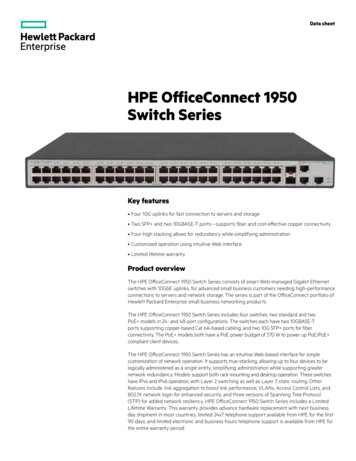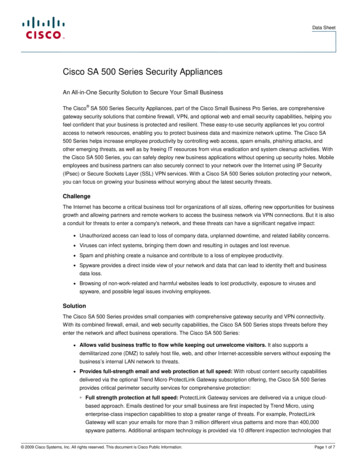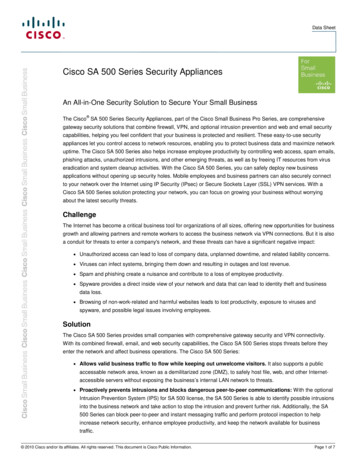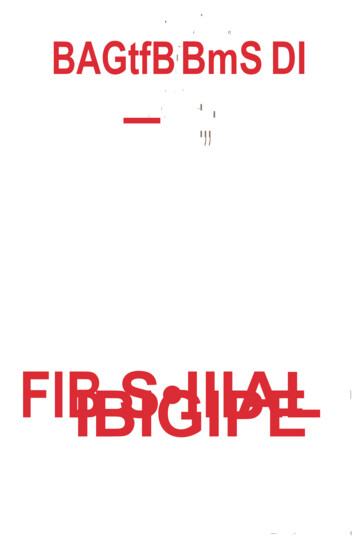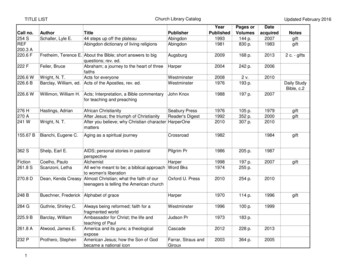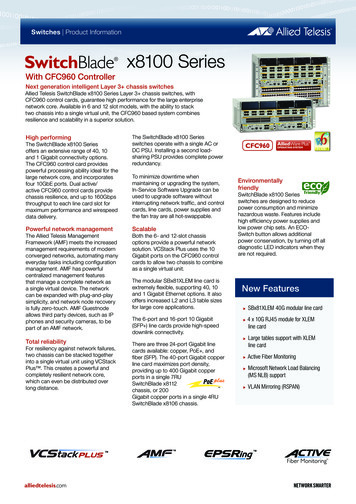
Transcription
Switches Product InformationSwitchBlade x8100 Series With CFC960 ControllerNext generation intelligent Layer 3 chassis switchesAllied Telesis SwitchBlade x8100 Series Layer 3 chassis switches, withCFC960 control cards, guarantee high performance for the large enterprisenetwork core. Available in 6 and 12 slot models, with the ability to stacktwo chassis into a single virtual unit, the CFC960 based system combinesresilience and scalability in a superior solution.High performingThe SwitchBlade x8100 Seriesoffers an extensive range of 40, 10and 1 Gigabit connectivity options.The CFC960 control card providespowerful processing ability ideal for thelarge network core, and incorporatesfour 10GbE ports. Dual active/active CFC960 control cards providechassis resilience, and up to 160Gbpsthroughput to each line card slot formaximum performance and wirespeeddata delivery.The SwitchBlade x8100 Seriesswitches operate with a single AC orDC PSU. Installing a second loadsharing PSU provides complete powerredundancy.To minimize downtime whenmaintaining or upgrading the system,In-Service Software Upgrade can beused to upgrade software withoutinterrupting network traffic, and controlcards, line cards, power supplies andthe fan tray are all hot-swappable.Powerful network managementScalableThe Allied Telesis ManagementFramework (AMF) meets the increasedmanagement requirements of modernconverged networks, automating manyeveryday tasks including configurationmanagement. AMF has powerfulcentralized management featuresthat manage a complete network asa single virtual device. The networkcan be expanded with plug-and-playsimplicity, and network node recoveryis fully zero-touch. AMF Guestnodeallows third party devices, such as IPphones and security cameras, to bepart of an AMF network.Both the 6- and 12-slot chassisoptions provide a powerful networksolution. VCStack Plus uses the 10Gigabit ports on the CFC960 controlcards to allow two chassis to combineas a single virtual unit.Total reliabilityFor resiliency against network failures,two chassis can be stacked togetherinto a single virtual unit using VCStackPlus . This creates a powerful andcompletely resilient network core,which can even be distributed overlong distance.alliedtelesis.comThe modular SBx81XLEM line card isextremely flexible, supporting 40, 10and 1 Gigabit Ethernet options. It alsooffers increased L2 and L3 table sizesfor large core applications.The 6-port and 16-port 10 Gigabit(SFP ) line cards provide high-speeddownlink connectivity.There are three 24-port Gigabit linecards available: copper, PoE , andfiber (SFP). The 40-port Gigabit copperline card maximizes port density,providing up to 400 Gigabit copperports in a single 7RUSwitchBlade x8112chassis, or 200Gigabit copper ports in a single 4RUSwitchBlade x8106 chassis.EnvironmentallyfriendlySwitchBlade x8100 Seriesswitches are designed to reducepower consumption and minimizehazardous waste. Features includehigh efficiency power supplies andlow power chip sets. An ECOSwitch button allows additionalpower conservation, by turning off alldiagnostic LED indicators when theyare not required.New Features ۼۼ SBx81XLEM 40G modular line card ۼۼ 4x 10G RJ45 module for XLEMline card ۼۼ Large tables support with XLEMline card ۼۼ Active ۼۼ Fiber MonitoringMicrosoft Network Load Balancing(MS NLB) support ۼۼ VLANMirroring (RSPAN)NETWORK SMARTER
SwitchBlade x8100 Series (CFC960) Intelligent Layer 3 Chassis Switches ۼۼ ۼۼ Key FeaturesVCStack Plus ۼۼ Two SwitchBlade x8100 chassis can be stackedtogether into a single virtual unit using VCStackPlus. The stacking link uses the 10 Gigabit frontpanel ports on the CFC960 control cards, whichprovides a massive 160 Gigabits of stackingbandwidth. VCStack Plus provides a highly availablesystem where network resources and distributionswitches are connected across the units forultimate resiliency. Management is simplified as thetwo chassis operate as a single virtual unit.Long-distance VCStack Plus ۼۼ As the VCStack Plus links are fiber, the twochassis do not need to be collocated, but can bekilometres apart - perfect for a distributed networkenvironment, or data-mirroring solution.Allied Telesis Management Framework(AMF) ۼۼ Allied Telesis Management Framework (AMF)is a sophisticated suite of management toolsthat provide a simplified approach to networkmanagement. Powerful features like centralizedmanagement, auto-backup, auto-upgrade, autoprovisioning and auto-recovery enable plug-andplay networking and zero-touch management. ۼۼ Any SwitchBlade x8100 Series switch can operateas the AMF network master, storing firmware andconfiguration backups for all other network nodes.The AMF master enables auto-provisioning andauto-upgrade by providing appropriate files to newnetwork members. New network devices can bepre-provisioned making installation easy becauseno on-site configuration is required. ۼۼ AMF Guestnode allows Allied Telesis wirelessaccess points and further switching products, aswell as third party devices such as IP phones andsecurity cameras, to be part of an AMF network.AMF Controller ۼۼ The CFC960 can manage AMF networks of up to120 nodes, which can be located locally or acrossWAN links. This can be dramatically increasedby installing the AMF Controller, which enablesmultiple AMF Masters to be managed from a singlepoint. With the AMF Controller, a network of over7,000 devices can be managed, allowing all thetime saving, cost reducing benefits of AMF to bemultiplied and efficiencies to be increased.In-Service Software Upgrade (ISSU) ۼۼ ISSU (also called "hitless firmware upgrade")allows firmware to be updated without causingany network disruption from a device reboot. Thisenables essential maintenance to be performedwhen it is required rather than having to schedule anetwork outage or tolerate any loss of service. ISSUis supported on dual controller systems and can beused in conjunction with VCStack Plus, making itideal for high availability applications.Virtual Routing and Forwarding(VRF Lite) ۼۼ VRF Lite provides Layer 3 network virtualization bydividing a single switch into multiple independentvirtual routing domains. With independent routingdomains, IP addresses can overlap without causingconflict, allowing multiple customers to havetheir own secure virtual network within the samephysical infrastructure.EPSRing (Ethernet ProtectionSwitched Ring) ۼۼ EPSRing combines with 40G or 10G Ethernetto allow several switches to form high-speedprotected rings capable of recovery within aslittle as 50ms. This feature is perfect for highperformance and high availability at the core ofenterprise or provider access networks. ۼۼ Superloop Protection enables a link between twoEPSR nodes to be in separate EPSR domains,improving redundancy and network fault resiliency.Access Control Lists (ACLs) ۼۼ AlliedWare Plus delivers industry-standardaccess control functionality with ACLs. ACLs filternetwork traffic to control whether routed packetsare forwarded or blocked at the port interface. Thisprovides a powerful network security mechanismto select the types of traffic to be analyzed,forwarded, or influenced in some way.Industry-leading Quality of Service(QoS) ۼۼ Comprehensive low-latency wirespeed QoSprovides flow-based traffic management withfull classification, prioritization, traffic shapingand min/max bandwidth profiles. Enjoy boostednetwork performance and guaranteed delivery ofbusiness-critical Ethernet services and applications.Time-critical services such as voice and videotake precedence over non-essential services suchas file downloads, maintaining responsiveness ofenterprise applications.Power over Ethernet Plus (PoE ) ۼۼ With PoE, a separate power connection to mediaend points such as IP phones and wireless accesspoints is not necessary. PoE provides evengreater flexibility, providing the capability to connectdevices requiring more power (up to 30 Watts)—for example, tilt and zoom security cameras. ۼۼ Configuration tasks can be automated as commandsmay be used in scripts. Triggers can also be utilized,providing a powerful mechanism for automatic andtimed management by automating the execution ofcommands in response to specific events. ۼۼ With three distinct modes, the CLI is very secure,and the use of encrypted remote login sessionsensures CLI access is not compromised.VLAN Mirroring (RSPAN) ۼۼ VLAN mirroring allows traffic from a port on aremote switch to be analysed locally. Traffic beingtransmitted or received on the port is duplicatedand sent across the network on a special VLAN.Optical DDM ۼۼ Most modern optical SFP/SFP /XFP transceiverssupport Digital Diagnostics Monitoring (DDM)functions according to the specification SFF-8472.This enables real time monitoring of the variousparameters of the transceiver, such as opticaloutput power, temperature, laser bias current andtransceiver supply voltage. Easy access to thisinformation simplifies diagnosing problems withoptical modules and fiber connections.Active Fiber Monitoring ۼۼ Active Fiber Monitoring prevents eavesdroppingon fiber communications by monitoring receivedoptical power. If an intrusion is detected, the linkcan be automatically shut down, or an operatoralert can be sent.sFlow ۼۼ sFlow is an industry standard technology formonitoring high-speed switched networks. It givescomplete visibility into network use, enablingperformance optimization, usage accounting/billing,and defence against security threats. Sampledpackets sent to a collector ensure it always has areal-time view of network traffic.Microsoft Network Load Balancing(MS NLB) Support ۼۼ Support for MS NLB, which clusters identicalservers together for increased performance throughload-sharing.Ease of management ۼۼ The AlliedWare Plus operating system incorporatesan industry standard CLI, facilitating intuitivemanageability.SBx81XLEM with Q2 moduleSBx81XS16SBx81CFC9602 SwitchBlade x8100 Series with CFC960
SwitchBlade x8100 Series (CFC960) Intelligent Layer 3 Chassis SwitchesKey SolutionsComplete network core resiliencyToday’s large enterprises demand ready access to onlineresources and applications. These needs require a highperforming network, one that can seamlessly carry multipleconverged services.Two SwitchBlade x8112 chassis with dual CFC960control cards combine to form a single virtual unit withVCStack Plus. This provides a powerful network core, withcomplete resiliency, and the simplicity of managing justone device. AMF allows the entire network to be unified formanagement, supporting plug-and-play networking withzero-touch expansion and recovery.Link aggregation across the two chassis to servers,network storage, and distribution switches leaves nosingle point of failure in this high performing network core,ensuring device and path resiliency. Each individual chassishas PSU redundancy to ensure maximum uptime.Hot-swappable PSUs, fan tray, control and line cardsallow for system maintenance and reconfiguration with nonetwork interruption.SwitchBlade x8106 chassis use high-speed 40 GigabitEthernet to deliver traffic from other buildings.Real-time applications like VoIP and streaming videoare assured premium service on the network, as nearhitless failover between the dual control cards on eachSwitchBlade x8112 means there is no perceptibledisruption in the case of a problem. Even if a wholechassis is powered down, access to online resources isretained without disruption.With the benefits of high availability, increased capacityand ease of management, VCStack Plus makes largenetworks reliable and simple.Guests10x2Members10x2410 0-2x5 x6010x2GuestsMembers410 0-2x5 utRoerutRoMembersDedicated WANto remote officeMembersInternet40 Gigabit link10 Gigabit link1 Gigabit linkLink aggregationNETWORK SMARTERSwitchBlade x8100 Series with CFC960 3
SwitchBlade x8100 Series (CFC960) Intelligent Layer 3 Chassis SwitchesKey SolutionsDistributed collapsed backboneAs large businesses spread across multiple buildings, bothonsite and across distances, their need for reliable accessto online resources and applications grows. Employeesexpect seamless connectivity to data center services from allbusiness locations.Allied Telesis VCStack Plus allows two SwitchBlade x8100chassis with dual CFC960 control cards to combine as asingle virtual unit. Fiber stacking connectivity means thatthe two chassis do not have to be collocated, but can bekilometres apart. This provides the complete resiliency ofa distributed backbone with separate physical units. It alsoretains the simplicity of a collapsed backbone network, withonly a single virtual core chassis to manage.With a chassis in two different locations, data centerservices can be mirrored for ‘always-on’ access, andto ensure automated disaster recovery. Each individualchassis has power and control resiliency to maximizeuptime. Management of the network core remains simple,as the virtual unit formed by the two SBx8100 chassiskeeps all switching and routing information completelysynchronized, for zero-touch failover.Long-distance VCStack Plus on the SwitchBlade x8100with CFC960 control cards makes the distributedcollapsed backbone a reality.Allied Telesis build networks that guarantee dataavailability for the large enterprise business.The distributed collapsed backbone encompasses the best ofboth worlds.0x5110x50x5110x510x2410 0-2x5 x600x2110x20x2110x2410 0-2x5 x600x2110x20x21Network AttachedStorageCorporateData CentermirrorVCStack10 Gigabit link1 Gigabit linkLink aggregation4 SwitchBlade x8100 Series with CFC960CorporateData ork AttachedStorageInternet
SwitchBlade x8100 Series (CFC960) Intelligent Layer 3 Chassis SwitchesProduct Specifications ۼۼ Hardware health monitoringResiliency featuresAT-SBx81CFC960 (Controller Fabric Card) ۼۼ Automatic link flap detection and port shutdown ۼۼ Control Plane Prioritization (CPP) ensures the ۼۼ Optical Digital Diagnostic Monitoring (DDM) ۼۼ 2GB SDRAM ۼۼ Ping polling and TraceRoute for IPv4 and IPv6 ۼۼ 512KB NVRAM ۼۼ 256MB flash memory ۼۼ Up to 128K MAC addresses and 100K routes(with SBx81XLEM)Up to 32K MAC addresses and 7K routes(with other line cards)132Mbit packet buffer memorySupports 10KB jumbo packets4K VLANs4 x 10GbE ports for stacking or uplinks1 ۼۼ ۼۼ ۼۼ ۼۼ ۼۼ AT-SBx81GP24 (24 x 10/100/1000T PoE line card)AT-SBx81GT24 (24 x 10/100/1000T line card) ۼۼ 12Mbit packet buffer memoryAT-SBx81GS24a (24 x 100/1000 SFP line card)AT-SBx81XS6 (6 x 10Gbps SFP line card) ۼۼ 24Mbit packet buffer memoryAT-SBx81GT40 (40 x 10/100/1000T RJ.5 line card)AT-SBx81XS16 (16 x 10GbE SFP line card)AT-SBx81XLEM (12 x 100/1000 SFP, 1 module slotline card) ۼۼ 32Mbit packet buffer memoryA maximum of 6 x AT-SBx81XS16 line cards can be installed inan SBx8112 chassis, and 5 in an SBx8106 chassisReliability ۼۼ Modular AlliedWare Plus operating system ۼۼ Redundant controller fabric cards ۼۼ Redundant 1200W AC or DC system powersupplies ۼۼ Load-sharing 1200W PoE power supplies ۼۼ Full environmental monitoring of PSUs, fans,temperature and internal voltages. SNMP trapsalert network managers in case of failure ۼۼ Over-temperature monitoring and alarmsExpandability ۼۼ 160Gbps of stacking bandwidth ۼۼ High-speed line slots support any mix ofhot-swappable cards for port flexibility ۼۼ A line card can be installed in the second CFC slotof the SBx8106 chassis for extra port density ۼۼ Premium license option for additional features ۼۼ AMF Master license options for 40, 80 and up to120 node networks ۼۼ Port and VLAN mirroring (RSPAN)IPv4 features ۼۼ Black hole routing ۼۼ Directed broadcast forwarding ۼۼ DNS relay ۼۼ Equal Cost Multi Path (ECMP) routing ۼۼ Policy-based routing ۼۼ Route maps and route redistribution (OSPF, BGP,RIP) ۼۼ IPv4 static unicast and multicast routing ۼۼ UDP broadcast helper (IP helper) ۼۼ Up to 64 Virtual Routing and Forwarding (VRF lite)domains (Premium license)IPv6 features ۼۼ DHCPv6 relay, DHCPv6 client ۼۼ DNSv6 relay, DNSv6 client ۼۼ IPv4 and IPv6 dual stack ۼۼ IPv6 QoS and hardware ACLs ۼۼ Device management over IPv6 networks withSNMPv6, Telnetv6, SSHv6 and Syslogv6 ۼۼ NTPv6 client and server ۼۼ IPv6 static unicast and multicast routingManagement ۼۼ Allied Telesis Management Framework (AMF) ۼۼ ۼۼ ۼۼ ۼۼ ۼۼ ۼۼ ۼۼ ۼۼ ۼۼ enables powerful centralized management andzero-touch device installation and recoveryTry AMF for free with the built-in AMF Starter licenseEco-friendly mode allows ports and LEDs to bedisabled to save powerIndustry-standard CLI with context-sensitive helpOut-of-band 10/100/1000T Ethernet managementport on the CFC front panel for ease of accessPowerful CLI scripting engine and built-in text editorComprehensive SNMP MIB support for standardsbased device managementManagement via Telnet or SSH to CLIEvent-based triggers allow user-defined scripts tobe executed upon selected system eventsUSB interface allows software release files,configurations and other files to be stored forbackup and distribution to other devicesQuality of Service (QoS) ۼۼ 8 priority queues with a hierarchy of high priorityFlexibility and compatibility ۼۼ Gigabit SFP ports will support any combination ofAllied Telesis SFP modules listed in this documentunder Ordering Information ۼۼ 10G SFP ports will support any combination ofAllied Telesis SFP modules and direct attachcables listed in this document under OrderingInformation ۼۼ 40G QSFP ports will support any combination ofAllied Telesis QSFP modules and cables listed inthis document under ordering information ۼۼ ۼۼ ۼۼ ۼۼ ۼۼ Diagnostic tools ۼۼ ۼۼ Active Fiber Monitoring detects tampering on ۼۼ optical links ۼۼ Cable fault locator (TDR) ۼۼ UniDirectional Link Detection (UDLD)1Depending on selected configurationNETWORK SMARTER ۼۼ ۼۼ queues for real time traffic, and mixed scheduling,for each switch portLimit bandwidth per port or per traffic class downto 64kbpsWirespeed traffic classification with low latencyessential for VoIP and real-time streaming mediaapplicationsPolicy-based QoS based on VLAN, port, MAC andgeneral packet classifiersPolicy-based storm protectionExtensive remarking capabilitiesTaildrop for queue congestion controlStrict priority, weighted round robin or mixedschedulingIP precedence and DiffServ marking based on layer2, 3 and 4 headersDSCP remarking based on TCP/UDP port number ۼۼ ۼۼ ۼۼ ۼۼ ۼۼ ۼۼ ۼۼ CPU always has sufficient bandwidth to processnetwork control trafficEPSRing (Ethernet Protection Switched Rings) withSuperLoop Protection (SLP)EPSR enhanced recovery for extra resiliencyLoop protection: loop detection and thrash limitingPVST compatibility modeSTP root guardVCStack Plus enables two SBx8100 chassis withCFC960 to form a stack for ultimate resiliency andsimplified managementIn-Service Software Upgrade provides hitlessfirmware update to prevent outages duringessential maintenanceSecurity features ۼۼ Access Control Lists (ACLs) based on layer 3 and4 headers ۼۼ Configurable ACLs for management traffic ۼۼ Auth-fail and guest VLANs ۼۼ Bootloader can be password protected for devicesecurity ۼۼ BPDU protection ۼۼ DHCP snooping, IP source guard and Dynamic ARPInspection (DAI) ۼۼ Dynamic VLAN assignment ۼۼ MAC address filtering and MAC address lock-down ۼۼ Network Access and Control (NAC) featuresmanage endpoint security ۼۼ Port-based learn limits (intrusion detection) ۼۼ Private VLANs provide security and port isolationfor multiple customers using the same VLAN ۼۼ Secure Copy (SCP) ۼۼ Strong password security and encryption ۼۼ Tri-authentication: MAC-based, web-based andIEEE 802.1x ۼۼ RADIUS group selection per VLAN or portEnvironmental specifications ۼۼ Operating temperature range:0 C to 40 C (32 F to 104 F).Derated by 1 C per 305 meters (1,000 ft) ۼۼ Storage temperature range:-25 C to 70 C (-13 F to 158 F) ۼۼ Operating relative humidity range:5% to 90% non-condensing ۼۼ Storage relative humidity range:5% to 95% non-condensing ۼۼ Operating altitude:3,048 meters maximum (10,000 ft)Electrical approvals and compliances ۼۼ EMC: EN55022 class A, FCC class A, VCCI class A ۼۼ Immunity: EN55024, EN61000-3-levels 2(Harmonics), and 3 (Flicker) – AC models onlySafety ۼۼ Standards: UL60950-1, CAN/CSA-C22.2No. 60950-1-03, EN60950-1, EN60825-1,AS/NZS 60950.1 ۼۼ Certification: UL, cUL, TUVRestrictions on Hazardous Substances(RoHS) Compliance ۼۼ EU and China RoHS compliantCountry of origin ۼۼ IndonesiaSwitchBlade x8100 Series with CFC960 5
SwitchBlade x8100 Series (CFC960) Intelligent Layer 3 Chassis SwitchesStandards and ProtocolsRFC 894AlliedWare Plus Operating SystemRFC 919RFC 922Version 5.4.6-1Border Gateway Protocol (BGP)BGP dynamic capabilityBGP outbound route filteringRFC 1772 Application of the Border Gateway Protocol(BGP) in the InternetRFC 1997 BGP communities attributeRFC 2385 Protection of BGP sessions via the TCP MD5signature optionRFC 2439 BGP route flap dampingRFC 2545 Use of BGP-4 multiprotocol extensions forIPv6 inter-domain routingRFC 2858 Multiprotocol extensions for BGP-4RFC 2918 Route refresh capability for BGP-4RFC 3392 Capabilities advertisement with BGP-4RFC 4271 Border Gateway Protocol 4 (BGP-4)RFC 4360 BGP extended communitiesRFC 4456 BGP route reflection - an alternative to fullmesh iBGPRFC 4724 BGP graceful restartRFC 4893 BGP support for four-octet AS number spaceRFC 5065 Autonomous system confederations for BGPCryptographic AlgorithmsFIPS Approved AlgorithmsEncryption (Block Ciphers): ۼۼ AES (ECB, CBC, CFB and OFB Modes) ۼۼ 3DES (ECB, CBC, CFB and OFB Modes)Block Cipher Modes: ۼۼ CCM ۼۼ CMAC ۼۼ GCM ۼۼ XTSDigital Signatures & Asymmetric Key Generation: ۼۼ DSA ۼۼ ECDSA ۼۼ RSASecure Hashing: ۼۼ SHA-1 ۼۼ SHA-2 (SHA-224, SHA-256, SHA-384. SHA-512)Message Authentication: ۼۼ HMAC (SHA-1, SHA-2(224, 256, 384, 512)Random Number Generation: ۼۼ DRBG (Hash, HMAC and Counter)Non FIPS Approved AlgorithmsRNG (AES128/192/256)DESMD5EthernetIEEE 802.1AXLink aggregation (static and LACP)IEEE 802.2 Logical Link Control (LLC)IEEE 802.3 EthernetIEEE 802.3ab1000BASE-TIEEE 802.3ad Static and dynamic link aggregationIEEE 802.3ae 10 Gigabit EthernetIEEE 802.3af Power over Ethernet (PoE)IEEE 802.3an 10GBASE-TIEEE 802.3at Power over Ethernet plus (PoE )IEEE 802.3az Energy Efficient Ethernet (EEE)IEEE 802.3ba 40 Gigabit EthernetIEEE 802.3u 100BASE-XIEEE 802.3x Flow control - full-duplex operationIEEE 802.3z 1000BASE-XIPv4 featuresRFCRFCRFCRFCRFC768791792793826User Datagram Protocol (UDP)Internet Protocol (IP)Internet Control Message Protocol (ICMP)Transmission Control Protocol (TCP)Address Resolution Protocol (ARP)6 SwitchBlade x8100 Series with CFC960RFC 932RFC 950RFC 951RFC 1027RFC 1035RFC 1042RFC 1071RFC 1122RFC 1191RFC 1256RFC 1518RFC 1519RFC 1542RFC 1591RFC 1812RFC 1918RFC 2581Standard for the transmission of IP datagramsover Ethernet networksBroadcasting Internet datagramsBroadcasting Internet datagrams in thepresence of subnetsSubnetwork addressing schemeInternet standard subnetting procedureBootstrap Protocol (BootP)Proxy ARPDNS clientStandard for the transmission of IP datagramsover IEEE 802 networksComputing the Internet checksumInternet host requirementsPath MTU discoveryICMP router discovery messagesAn architecture for IP address allocation withCIDRClassless Inter-Domain Routing (CIDR)Clarifications and extensions for BootPDomain Name System (DNS)Requirements for IPv4 routersIP addressingTCP congestion controlIPv6 featuresRFC 1981RFC 2460RFC 2464RFC 3056RFC 3484RFC 3596RFC 4007RFC 4193RFC 4291RFC 4443RFC 4861RFC 4862RFC 5014RFC 5095RFC 5175RFC 6105Path MTU discovery for IPv6IPv6 specificationTransmission of IPv6 packets over EthernetnetworksConnection of IPv6 domains via IPv4 cloudsDefault address selection for IPv6DNS extensions to support IPv6IPv6 scoped address architectureUnique local IPv6 unicast addressesIPv6 addressing architectureInternet Control Message Protocol (ICMPv6)Neighbor discovery for IPv6IPv6 Stateless Address Auto-Configuration(SLAAC)IPv6 socket API for source address selectionDeprecation of type 0 routing headers in IPv6IPv6 Router Advertisement (RA) flags optionIPv6 Router Advertisement (RA) guardRFC 3412RFC 3413RFC 3414RFC 3415RFC 3416RFC 3417RFC 3418RFC 3621RFC 3635RFC 3636RFC 4022RFC 4113RFC 4293RFC 4188RFC 4318RFC 4560RFC 6527Message processing and dispatching for theSNMPSNMP applicationsUser-based Security Model (USM) for SNMPv3View-based Access Control Model (VACM) forSNMPVersion 2 of the protocol operations for theSNMPTransport mappings for the SNMPMIB for SNMPPower over Ethernet (PoE) MIBDefinitions of managed objects for theEthernet-like interface typesIEEE 802.3 MAU MIBSNMPv2 MIB for TCP using SMIv2SNMPv2 MIB for UDP using SMIv2SNMPv2 MIB for IP using SMIv2Definitions of managed objects for bridgesDefinitions of managed objects for bridgeswith RSTPDefinitions of managed objects for remote ping,traceroute and lookup operationsDefinitions of managed objects for VRRPv3Multicast supportBootstrap Router (BSR) mechanism for PIM-SMIGMP query solicitationIGMP snooping (v1, v2 and v3)IGMP/MLD multicast forwarding (IGMP/MLD proxy)MLD snooping (v1 and v2)PIM-SM and SSM for IPv6RFC 1112 Host extensions for IP multicasting (IGMPv1)RFC 2236 Internet Group Management Protocol v2(IGMPv2)RFC 2710 Multicast Listener Discovery (MLD) for IPv6RFC 2715 Interoperability rules for multicast routingprotocolsRFC 3376 IGMPv3RFC 3810 Multicast Listener Discovery v2 (MLDv2) forIPv6RFC 3973 PIM Dense Mode (DM)RFC 4541 IGMP and MLD snooping switchesRFC 4601 Protocol Independent Multicast - Sparse Mode(PIM-SM): protocol specification (revised)ManagementOpen Shortest Path First (OSPF)AT Enterprise MIBAMF MIB and trapsVCS MIB and trapsOptical DDM MIBSNMPv1, v2c and v3IEEE 802.1ABLink Layer Discovery Protocol (LLDP)RFC 1155 Structure and identification of managementinformation for TCP/IP-based InternetsRFC 1157 Simple Network Management Protocol (SNMP)RFC 1212 Concise MIB definitionsRFC 1213 MIB for network management of TCP/IP-basedInternets: MIB-IIRFC 1215 Convention for defining traps for use with theSNMPRFC 1227 SNMP MUX protocol and MIBRFC 1239 Standard MIBRFC 1724 RIPv2 MIB extensionRFC 2096 IP forwarding table MIBRFC 2578 Structure of Management Information v2(SMIv2)RFC 2579 Textual conventions for SMIv2RFC 2580 Conformance statements for SMIv2RFC 2674 Definitions of managed objects for bridgeswith traffic classes, multicast filtering andVLAN extensionsRFC 2741 Agent extensibility (AgentX) protocolRFC 2787 Definitions of managed objects for VRRPRFC 2819 RMON MIB (groups 1,2,3 and 9)RFC 2863 Interfaces group MIBRFC 3164 Syslog protocolRFC 3176 sFlow: a method for monitoring traffic inswitched and routed networksRFC 3411 An architecture for describing SNMPmanagement frameworksOSPF link-local signalingOSPF MD5 authenticationOSPF restart signalingOut-of-band LSDB resyncRFC 1245 OSPF protocol analysisRFC 1246 Experience with the OSPF protocolRFC 1370 Applicability statement for OSPFRFC 1765 OSPF database overflowRFC 2328 OSPFv2RFC 2370 OSPF opaque LSA optionRFC 2740 OSPFv3 for IPv6RFC 3101 OSPF Not-So-Stubby Area (NSSA) optionRFC 3509 Alternative implementations of OSPF areaborder routersRFC 3623 Graceful OSPF restartRFC 3630 Traffic engineering extensions to OSPFRFC 4552 Authentication/confidentiality for OSPFv3RFC 5329 Traffic engineering extensions to OSPFv3Quality of Service (QoS)IEEE 802.1p Priority taggingRFC 2211 Specification of the controlled-load networkelement serviceRFC 2474 DiffServ precedence for eight queues/portRFC 2475 DiffServ architectureRFC 2597 DiffServ Assured Forwarding (AF)RFC 3246 DiffServ Expedited Forwarding (EF)Resiliency featuresIEEE 802.1DIEEE 802.1sIEEE 802.1wRFC 5798MAC bridgesMultiple Spanning Tree Protocol (MSTP)Rapid Spanning Tree Protocol (RSTP)Virtual Router Redundancy Protocol version 3(VRRPv3) for IPv4 and IPv6
SwitchBlade x8100 Series (CFC960) Intelligent Layer 3 Chassis SwitchesRFC 3579Routing Information Protocol (RIP)RFC 1058RFC 2080RFC 2081RFC 2082RFC 2453Routing Information Protocol (RIP)RIPng for IPv6RIPng protocol applicability statementRIP-2 MD5 authenticationRIPv2RFC 3580RFC 3748RFC 4251RFC 4252RFC 4253RFC 4254RFC 5246Security featuresSSH remote loginSSLv2 and SSLv3TACACS accounting and authenticationIEEE 802.1X authentication protocols (TLS, TTLS, PEAP andMD5)IEEE 802.1X multi-supplicant authenticationIEEE 802.1X port-based network access controlRFC 2818 HTTP over TLS ("HTTPS")RFC 2865 RADIUSRFC 2866 RADIUS accountingRFC 2868 RADIUS attributes for tunnel protocol supportRFC 3280 Internet X.509 PKI Certificate and CertificateRevocation List (CRL) profileRFC 3546 Transport Layer Security (TLS) extensionsRADIUS support for Extensible AuthenticationProtocol (EAP)IEEE 802.1x RADIUS usage guidelinesPPP Extensible Authentication Protocol (EAP)Secure Shell (SSHv2) protocol architectureSecure Shell (SSHv2) authentication protocolSecure Shell (SSHv2) transport layer protocolSecure Shell (SSHv2) connection protocolTLS v1.2Telnet protocol specificationTelnet option specificationsTelnet echo optionTelnet suppress go ahead optionTelnet terminal-type optionTrivial File Transfer Protocol (TFTP)SMTP service extensionMIMEDHCPv4 (server, relay and client)DHCP options and BootP vendor extensionsSMTP service extension for authenticationHypertext Transfer Protocol - HTTP/1.1Physical specificationsProductAT-SBx8112 chassisDimensions (WxDxH)48.0 x 38.8 x 31.0 cmWeight (kg/lbs)17.8 kg (39.1 lb)AT-SBx8106 chassisAT-SBx81CFC960 controller fabric cardAT-SBx81GP24 PoE line cardAT-SBx81GT24 line cardAT-SBx81GT40 RJ.5 line cardAT-SBx81GS24a SFP line cardAT-SBx81XS6 SFP line cardAT-SBx81XS16 SFP line cardAT-SBx81XLEM 40G modular line cardAT-SBxPWRSYS2 AC system PSUAT-SBxPWRSYS1-80 DC system PSUAT-SBxPWRPOE1 PoE power supply
In-Service Software Upgrade can be used to upgrade software without interrupting network traffic, and control cards, line cards, power supplies and the fan tray are all hot-swappable. Scalable Both the 6- and 12-slot chassis options provide a powerful network solution. VCStack Plus uses the 10 Gigabit ports on the CFC960 control


